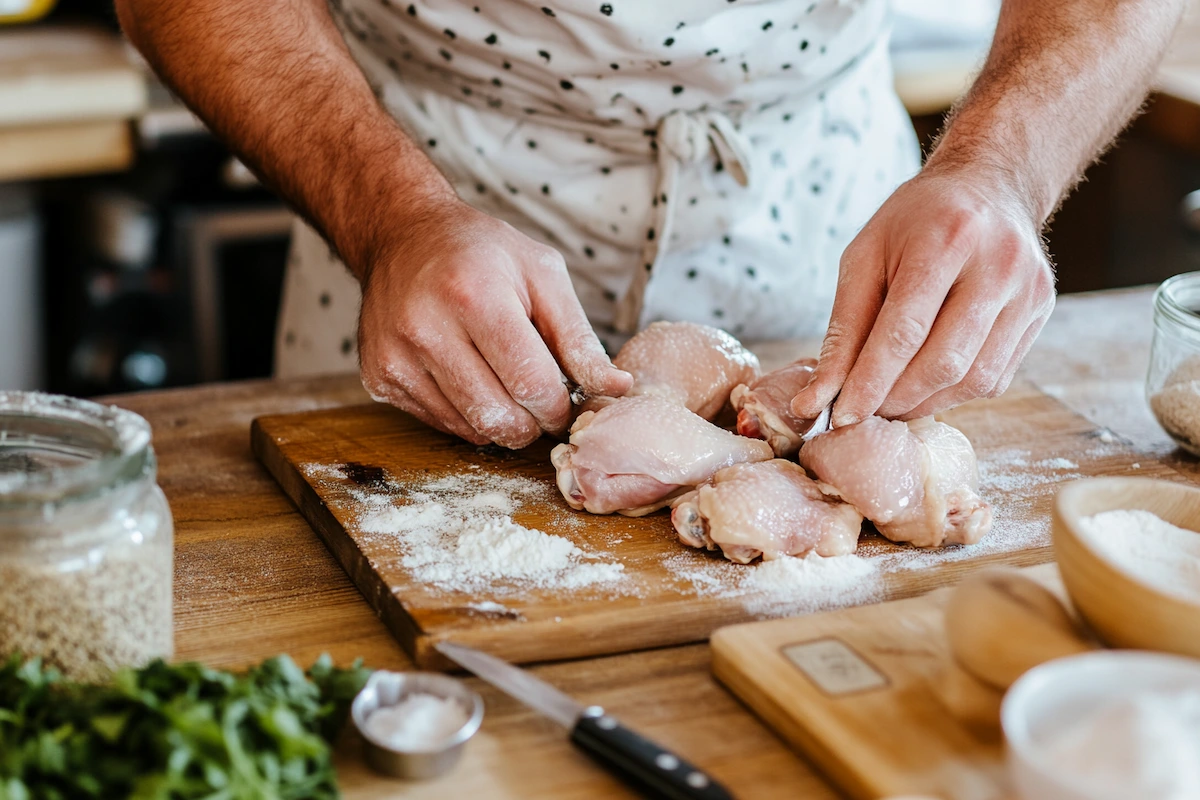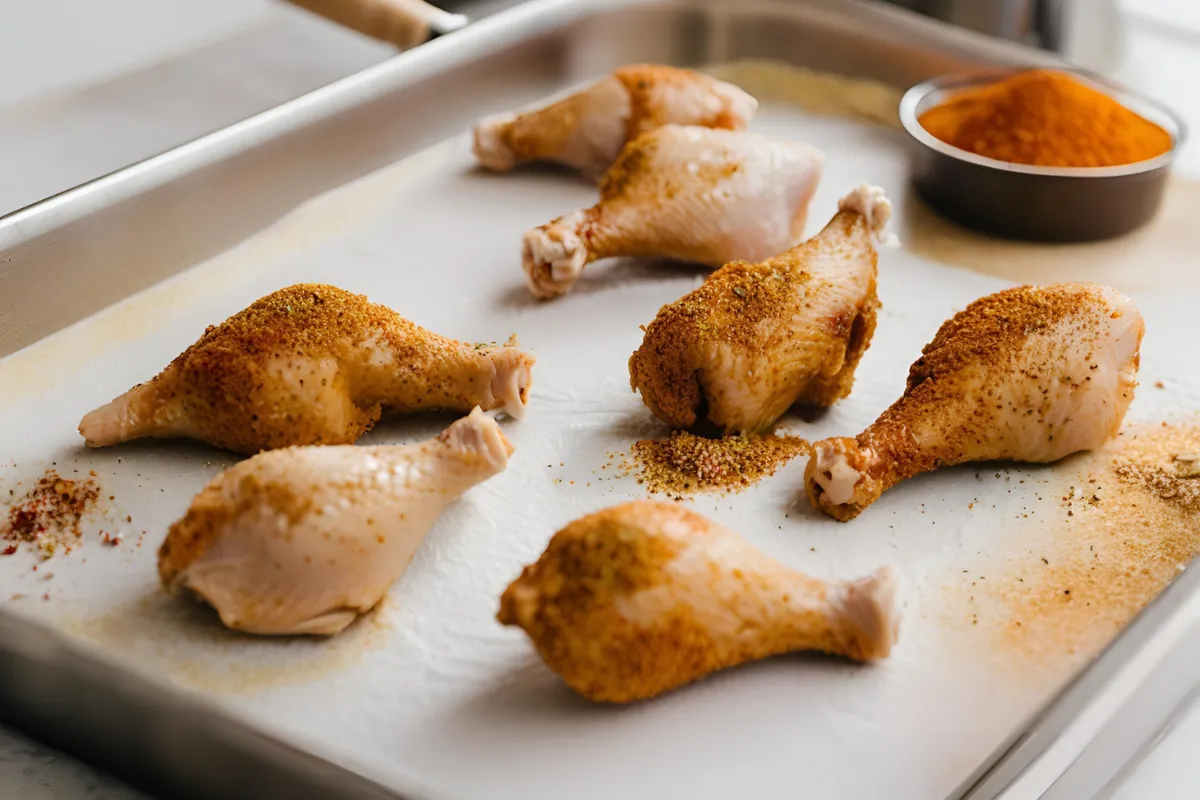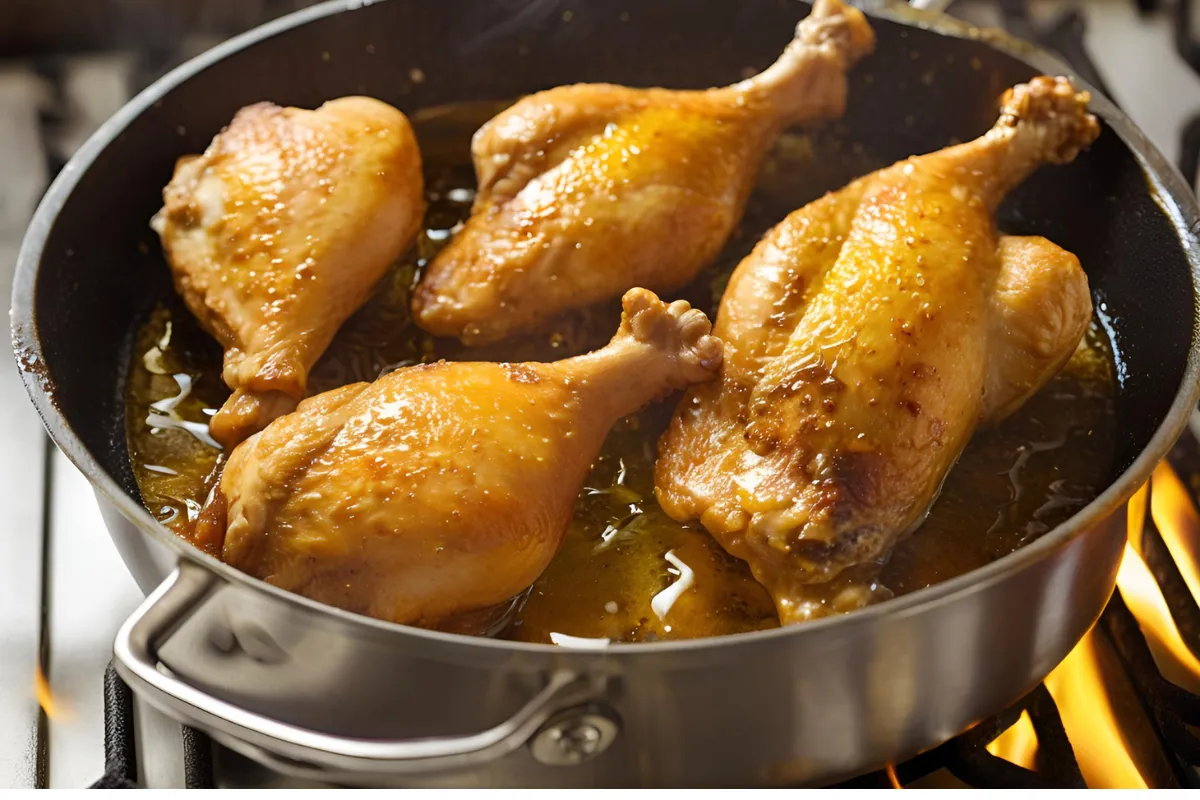Introduction
Frying chicken legs is a popular and delicious way to prepare this flavorful cut of meat, but it can be tricky to get them just right. From ensuring that the chicken is fully cooked to achieving that crispy, golden-brown skin, there’s a fine balance that needs to be struck. In this article, we’ll answer the burning question: How long does a chicken leg take to fry? We’ll also discuss factors that influence frying time, share tips for optimal results, and walk you through the step-by-step process of frying chicken legs to perfection. Let’s get started!
How Long Does a Chicken Leg Take to Fry?
Frying chicken legs seems straightforward, but there are a few key factors that can influence how long they take to cook. The general frying time for chicken legs depends on the temperature of the oil, the size of the chicken legs, and the method you use for frying. So, how long does a chicken leg take to fry? On average, it will take around 12 to 15 minutes to fry a chicken leg, but the time can vary based on several factors.
Frying Time for Chicken Legs – The Ideal Duration
The perfect frying time for chicken legs hinges on one main thing: temperature. If you’re frying the chicken in a deep fryer or a pot of oil, the temperature should be around 350°F (175°C). At this temperature, the chicken will cook evenly, and the coating will crisp up beautifully. Typically, 12 minutes will be enough to fry chicken legs to perfection, but be sure to check the internal temperature.
Internal Temperature is Key
The best way to tell if your chicken legs are done is by checking the internal temperature. You’ll want the meat to reach an internal temperature of 165°F (74°C). If you don’t have a meat thermometer, another way to check is by cutting into the thickest part of the chicken leg. If the juices run clear and the meat is no longer pink, your chicken is good to go.
Factors That Affect Frying Time for Chicken Legs
Several factors can affect the time it takes to fry chicken legs, and understanding these variables will help you get the best results:
- Oil Temperature: Keeping the oil at the right temperature is crucial. If the oil is too cold, the chicken will absorb too much oil and become greasy. If it’s too hot, the chicken will burn on the outside while remaining raw inside. The ideal temperature for frying chicken legs is 350°F to 375°F (175°C to 190°C).
- Size of the Chicken Legs: Larger chicken legs may require a little more time to cook through than smaller ones. A good rule of thumb is that bigger legs may take 15 minutes or a bit longer, while smaller ones might be done in 12 minutes.
- Thickness of the Coating: If you coat your chicken legs in a thick batter or breading, it will naturally take a little longer for the chicken to cook. The thicker the coating, the longer the frying time needed to get it crispy without burning.
- Frying Method: There are several ways to fry chicken legs, and each method affects the cooking time. Deep frying typically takes less time, while shallow frying might take a bit longer because you’re not fully submerging the chicken in oil. Keep in mind that frying in a skillet requires more attention to ensure even cooking.
Adjusting Frying Time Based on Cooking Method
If you’re using a deep fryer, the chicken will cook faster since it’s fully immersed in hot oil. Expect 12 minutes for most standard-sized chicken legs. However, if you’re shallow frying in a pan, it might take slightly longer. You’ll want to turn the chicken legs every few minutes to ensure they cook evenly on all sides.
Preparing the Chicken Legs for Frying
Once you know how long to fry chicken legs, the next important step is preparing them. Proper preparation can make a huge difference in achieving the perfect crispy, flavorful chicken. Here’s a detailed guide to ensure your chicken legs are ready for frying!
How to Properly Prepare Chicken Legs for Frying
Before you even think about seasoning, there are a few key steps to take when preparing chicken legs for frying.
- Thaw the Chicken Legs: If your chicken legs are frozen, make sure to thaw them completely. The best way to do this is by placing them in the fridge overnight. Never thaw chicken legs at room temperature, as this can lead to uneven cooking and potential bacterial growth. If you’re short on time, you can use the defrost function on your microwave, but be careful not to start cooking them in the process.
- Trim the Chicken Legs: While chicken legs don’t require much trimming, you might want to remove any excess skin or fat. Trimming some of the skin will prevent it from becoming too greasy during frying, but leave a good portion on to maintain moisture and crispiness.
- Clean and Pat Dry: One of the most important steps in preparing chicken legs for frying is to ensure they’re dry. Rinse the chicken legs under cold water and then use paper towels to pat them dry thoroughly. Moisture on the surface of the chicken will interfere with the oil’s ability to crisp the coating, so make sure they’re as dry as possible.
- Poke Holes (Optional): If you want to make sure the heat penetrates the chicken leg evenly, you can gently poke a few holes in the thicker parts of the meat using a fork or knife. This step is optional but can be helpful, especially with larger chicken legs.
Seasoning Options
The next crucial step is seasoning. What you put on the chicken legs can make or break the flavor. There are a variety of ways to season chicken legs before frying, from simple salt and pepper to complex marinades.
- Dry Rubs: A dry rub is one of the easiest ways to flavor chicken legs before frying. Combine spices like paprika, garlic powder, onion powder, salt, and black pepper in a bowl. If you want extra kick, consider adding cayenne pepper or chili powder. Rub the mixture generously all over the chicken legs, making sure to coat every nook and cranny.
- Marinades: If you have more time, marinating chicken legs can take the flavor to the next level. A marinade typically consists of oil, acid (like lemon juice or vinegar), and spices. You can mix olive oil, lemon juice, garlic, and thyme for a Mediterranean twist, or use soy sauce, brown sugar, and ginger for an Asian-inspired flavor. Let the chicken marinate in the fridge for at least 30 minutes but ideally for several hours for deeper flavor penetration.
- Simple Salt and Pepper: If you prefer a minimalist approach, simply season your chicken legs with salt and pepper. The high heat from frying will bring out the natural flavors of the chicken, and a light sprinkle of salt and pepper enhances that savory goodness.
- Pre-Seasoned Coatings: Some people prefer to use pre-made seasoning mixes or coatings that you can easily find in stores. While these are convenient, they might not offer the same depth of flavor as a homemade seasoning blend. However, if you’re short on time, this is a good option for quick and flavorful fried chicken legs.
Marinating Chicken Legs for Better Flavor
Marinating is a powerful way to infuse flavors into your chicken legs, especially if you’re aiming for a juicy, flavorful result. Why should you marinate chicken legs before frying? Because marinating allows the meat to absorb spices, herbs, and other flavorings, which results in a more flavorful end product. Marinating also helps tenderize the meat, giving it a juicy texture after frying.
When it comes to marinating, there are a variety of options depending on your flavor preferences. You can go for a tangy buttermilk marinade (a classic choice for fried chicken), or choose something with a bit of heat, like a hot sauce-based marinade.
Marinating Tips:
- Ideal Time: Marinate your chicken legs for at least 30 minutes; however, for the best flavor, marinate them for 2-4 hours. You can even marinate overnight for the most flavorful results. But don’t leave them in the marinade too long, as acidic marinades (like those with lemon or vinegar) can start to break down the meat, making it mushy.
- Acidic Components: If you’re looking to create a marinade that really enhances the flavor, make sure it includes an acidic ingredient. This helps tenderize the chicken legs and allows the spices to better penetrate the meat.
By following these steps for proper preparation and seasoning, your chicken legs will be ready for frying. In the next part, we’ll dive into the frying process, including ideal oil temperature, timing, and tips for achieving that crispy texture everyone loves.
Frying Chicken Legs
Now that your chicken legs are prepped and seasoned, it’s time to fry them to crispy perfection! The frying process can seem intimidating, but with the right temperature and technique, you’ll get that golden, crispy texture on the outside while keeping the juicy tenderness on the inside. Let’s walk through everything you need to know.
What Temperature Should the Oil Be for Frying Chicken Legs?
One of the most important factors in achieving crispy, perfectly fried chicken legs is the oil temperature. If the oil is too cool, the chicken will absorb excess oil and become greasy. If it’s too hot, the outside will burn while the inside stays raw. To strike that perfect balance, the oil should be heated to 350°F to 375°F (175°C to 190°C).
Why this range? Because at 350°F (175°C), the chicken will cook evenly while the outer coating becomes crispy without absorbing too much oil. At the higher end of the range (375°F (190°C)), you get an even crispier finish. The key here is to make sure the temperature remains consistent. If the oil cools down too much when the chicken goes in, the result will be greasy, soggy chicken.
To check the oil temperature, you can use a thermometer, or if you don’t have one, you can drop in a small piece of bread. If it browns in about 60 seconds, the oil is ready.
How Long Does It Take to Fry a Chicken Leg (Depending on Size)?
The time it takes to fry a chicken leg can vary depending on several factors, including the size of the leg, whether it’s bone-in or boneless, and the temperature of the oil. Generally, it will take around 12 to 15 minutes for chicken legs to fry to crispy perfection.
- Bone-In Chicken Legs: Bone-in chicken legs take longer to cook because the bone acts as an insulator. Fry them for 12 to 15 minutes. Larger legs may need closer to 15 minutes, while smaller ones typically cook in about 12 minutes.
- Boneless Chicken Legs: Boneless chicken legs (often called boneless thighs) cook faster. Fry them for 8 to 12 minutes in hot oil. Since they cook quickly, watch them closely to avoid overcooking.
- Oil Temperature: The higher the temperature of the oil, the faster the chicken will cook. So, if you’re frying at 375°F (190°C), expect the chicken to cook faster than if you’re frying at 350°F (175°C). Keep in mind that you need to check for doneness by making sure the internal temperature of the chicken reaches 165°F (74°C). A meat thermometer is your best friend here!
Steps to Fry Chicken Legs to Perfection
Frying chicken legs is an art, and following the right steps will ensure they come out crispy and perfectly cooked every time. Here’s a step-by-step guide:
- Heat the Oil: Pour enough oil into a deep fryer or large pan to fully submerge the chicken legs. Heat the oil to 350°F to 375°F (175°C to 190°C). Use a thermometer to ensure accuracy.
- Add the Chicken Legs: Once the oil is at the right temperature, carefully place the chicken legs into the oil. It’s important not to overcrowd the pan. If the chicken legs are too crowded, the oil temperature will drop, leading to soggy chicken.
- Fry Evenly: Fry the chicken legs for about 12 to 15 minutes, turning them occasionally to ensure even cooking. If the legs are larger, you may need to cook them for a little longer. Use a thermometer to check the internal temperature of the chicken, aiming for 165°F (74°C).
- Remove and Rest: Once the chicken legs are golden brown and crispy, remove them from the oil and let them drain on a wire rack or paper towels. This helps remove excess oil and keeps the chicken crispy.
- Check Doneness: Cut into the thickest part of a chicken leg to check if the juices run clear. If the chicken is still pink, return it to the oil for a few more minutes until fully cooked.
Common Mistakes to Avoid While Frying Chicken Legs
Frying chicken legs may seem easy, but it’s easy to make a few mistakes that can ruin the final result. Let’s take a look at some common errors and how to avoid them.
- Overcrowding the Pan: One of the most common mistakes is overcrowding the pan with too many chicken legs. When the chicken legs are too close together, the oil temperature drops, and the chicken ends up cooking unevenly. Always leave space between the chicken pieces, ensuring the oil can circulate around them.
- Incorrect Oil Temperature: Not heating the oil to the correct temperature is another mistake. Too cool, and the chicken absorbs too much oil. Too hot, and it could burn on the outside before cooking fully inside. Keep an eye on the temperature and adjust as needed.
- Skipping the Drying Process: If you don’t dry your chicken properly before frying, moisture will prevent the oil from creating a crispy texture. Always pat your chicken legs dry with paper towels before frying.
- Not Using a Thermometer: Guessing whether your chicken is cooked can be risky. Without a meat thermometer, you might serve undercooked chicken. Always check the internal temperature to ensure it reaches 165°F (74°C).
By avoiding these mistakes, you’ll be on your way to crispy, perfectly fried chicken legs every time.
After Frying – Tips and Tricks
Now that your chicken legs are perfectly fried, it’s time for a few final steps to ensure they’re cooked through, crispy, and ready to be enjoyed. These after-frying tips are key to keeping your chicken juicy and flavorful while achieving that crisp, golden skin.
How to Check if Chicken Legs Are Fully Cooked
Even though frying your chicken legs to a crispy golden brown is an excellent sign, you still need to ensure that the meat is fully cooked inside. Undercooked chicken is not only unsafe to eat but can also ruin the meal. So, how can you check?
- Using a Meat Thermometer: The most reliable way to check if your chicken legs are fully cooked is by using a meat thermometer. Insert the thermometer into the thickest part of the chicken leg, avoiding the bone. The chicken is fully cooked when the internal temperature reaches 165°F (74°C). If the temperature is below this, return the chicken to the oil for a few more minutes.
- Visual Check: If you don’t have a thermometer, you can make a small cut into the thickest part of the chicken leg to check if the meat is cooked. The juices should run clear, not pink or bloody. If there’s any pinkness in the meat, the chicken isn’t done and should go back into the fryer for a few more minutes.
- Touch Test: Another quick way to check if chicken is cooked is by gently pressing the meat. If it’s firm to the touch, it’s likely cooked through. If it feels soft and squishy, give it a little more time.
Resting and Draining the Chicken Legs for Crispiness
Once your chicken legs are fried to golden perfection, don’t rush to serve them just yet! Letting them rest and draining off excess oil are crucial steps to enhance both the texture and flavor of your fried chicken.
- Let the Chicken Rest: After frying, it’s important to let your chicken legs rest for about 5 minutes before serving. Resting helps redistribute the juices inside the meat, making it tender and juicy. If you cut into the chicken right away, the juices will spill out, and the meat could end up dry.
- Drain the Excess Oil: To maintain that crispy exterior, place the chicken legs on a wire rack or a plate lined with paper towels. This will allow excess oil to drip off, preventing the chicken from becoming soggy. A wire rack is the best option because it elevates the chicken, allowing air to circulate around it and keeping it crispy on all sides.
By letting the chicken rest and draining excess oil, you’ll ensure that your fried chicken legs are as juicy on the inside as they are crispy on the outside.
Serving Ideas and Side Dishes for Fried Chicken Legs
Fried chicken legs make for a satisfying meal on their own, but they’re even better when paired with the right sides. Here are a few ideas for what to serve alongside your crispy chicken legs:
- Mashed Potatoes: A classic comfort food, mashed potatoes are the perfect side dish to balance the crunch of fried chicken. For extra flavor, top them with some gravy or butter.
- Coleslaw: A cool and tangy coleslaw complements the richness of fried chicken legs beautifully. The crunch of the cabbage provides a nice contrast to the crispy chicken.
- Cornbread: Sweet, soft cornbread pairs wonderfully with fried chicken, especially when served warm. A drizzle of honey butter will take it to the next level.
- Steamed Vegetables: If you’re looking for a healthier side, steamed vegetables like broccoli, carrots, or green beans are a great option. The freshness of the vegetables balances out the fried chicken and adds color to your plate.
- Dips and Sauces: Fried chicken legs go hand-in-hand with a variety of sauces. Try a tangy BBQ sauce, honey mustard, ranch, or even a spicy buffalo sauce for dipping. You can also serve a side of pickles or a spicy hot sauce to kick up the flavor.
These side dishes will complement your fried chicken legs and create a balanced, satisfying meal that everyone will love!
FAQs Section
What is the best oil for frying chicken legs?
When frying chicken legs, the best oils are those with a high smoke point, which allows them to handle the high temperatures needed for frying without burning. Peanut oil, canola oil, and vegetable oil are all excellent choices. Peanut oil, in particular, is a favorite for frying because it has a neutral flavor and a high smoke point, around 450°F (232°C), which helps achieve that golden crispy texture. Sunflower oil and grapeseed oil are also good options. Avoid oils with lower smoke points, like olive oil, as they can burn at the frying temperatures needed for crispy chicken.
Can you fry chicken legs without flour?
Yes, you can fry chicken legs without flour! While flour helps create a crispy, crunchy coating, you can achieve a delicious fried chicken without it. Instead of flour, you can use cornstarch, breadcrumbs, or even panko crumbs for a different texture. If you prefer a gluten-free option, cornmeal is a great substitute. You can also opt for a bare fried chicken leg, seasoned directly on the skin. This will give you a less crispy, but still flavorful, result. So, while flour is traditional, it’s not the only way to fry chicken legs.
Why are my chicken legs not crispy when fried?
If your chicken legs aren’t crispy when fried, several factors could be at play. One common issue is oil temperature. If the oil is too cold, the chicken will absorb excess oil and turn greasy instead of crispy. Heat the oil to 350°F (175°C) before frying and maintain a consistent temperature. Moisture on the chicken’s surface can also affect crispiness. Pat the chicken dry with paper towels before frying to prevent sogginess. Additionally, overcrowding the pan can lower the oil temperature and cause uneven cooking, resulting in a lack of crispiness.
Should you cover chicken legs while frying?
It’s generally not recommended to cover chicken legs while frying, as doing so traps steam and moisture, which can make the coating soggy. The goal of frying is to keep the chicken exposed to the hot oil to form a crispy outer layer. However, if you’re shallow frying and notice that the chicken is cooking unevenly, you can partially cover the pan for a short time to help cook the chicken through without lowering the oil temperature too much. Just remember to remove the cover once the chicken is near the desired doneness to maintain that crispy skin.
Conclusion: Final Thoughts on Frying Chicken Legs Perfectly
Frying chicken legs to perfection is all about the right combination of timing, temperature, and preparation. By carefully following the steps—from properly prepping the chicken and seasoning it well, to maintaining the right oil temperature—you can ensure a crispy, golden exterior and juicy, tender meat inside.
Remember, the key to crispy chicken legs is maintaining an oil temperature between 350°F to 375°F (175°C to 190°C) and cooking the chicken for about 12 to 15 minutes depending on size. Always check the internal temperature with a meat thermometer to guarantee the chicken is fully cooked at 165°F (74°C).
Lastly, don’t forget the finishing touches: let the chicken rest and drain any excess oil to lock in that perfect crispiness. With these simple tips, you’ll be able to serve up fried chicken legs that are sure to impress every time.
Now that you know all the steps, you’re ready to fry chicken legs like a pro! Happy cooking!




